Bantam chickens – or “bantys”, as they are often called, are the best survival chicken breed a prepper could raise. This miniature chicken breed has value for survival homesteaders regardless if they live in a tiny plot of land, or copious amounts of acres.
Bantam chickens are essentially a miniature breed. They are approximately one-fourth the size of a standard chicken. While they obviously are not going to produce as much meat as a standard chicken (and definitely not as much as a “meat bird” breed), banty meat is still quite tender and tasty.
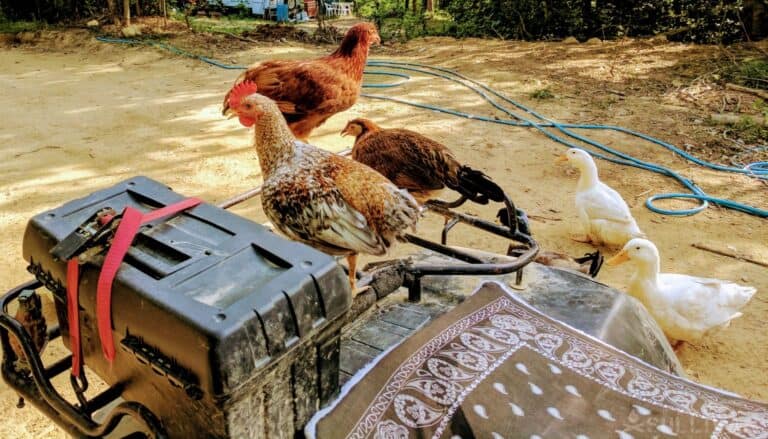
Raising more Bantam chickens to produce the amount of meat your family will need is entirely feasible even with limited space and is entirely economical. Mature banty hens and roosters that do not free range still only consume one pound of food per month.
The American Bantam Association recognized more than 400 breeds in their standards book. This means any type of favorite chicken breed you are already keeping or favor, can almost assuredly be found in a banty variety.
All of the breed demeanor, egg laying, meat producing, and hardiness characteristics you know and love can come in a pint size version.
Bantam Chicken Pros And Cons
| Pros | Cons |
|---|---|
| ✅ Hardy | ❌ Can be hard to handle if not tamed as chicks, and handled frequently into maturity. |
| ✅ Less destructive to garden crops | ❌ More susceptible to hawk attack even once mature due to their slight weight. |
| ✅ Easy going personalities – for the most part | ❌ Are almost always sold as straight run instead of sexed chicks due to their small size. |
Eggs
Not only are Bantam chicken breeds highly regarded for their consistent egg producing abilities, they have been traditionally kept by farmers and homesteaders for their superior sitting ability. Depending upon the breed, Bantam hens lay 150 to 200 eggs per year on average.
The eggs laid by Bantam hens are only small to medium in size. The eggs vary in color greatly by specific banty breed, but all produce creamy eggs inside of hardy shells.
When cooking with Bantam eggs you should use three banty eggs in replacement of every two standard eggs called for in a recipe.
Banty hens are excellent momma birds and routinely accept the eggs of other chickens, even those produced by standard size breeds – and sometimes even duck eggs. A little banty hen will fight to the death to protect her eggs and chicks, both from predators and even other members of her flock, if necessary.
On average, you should expect at least three to four eggs per week from Bantam hens. Some will lay everyday, but others will not. In my experience, the number of eggs laid by banty hens is about equal to those laid by standard size breed hens – just smaller.
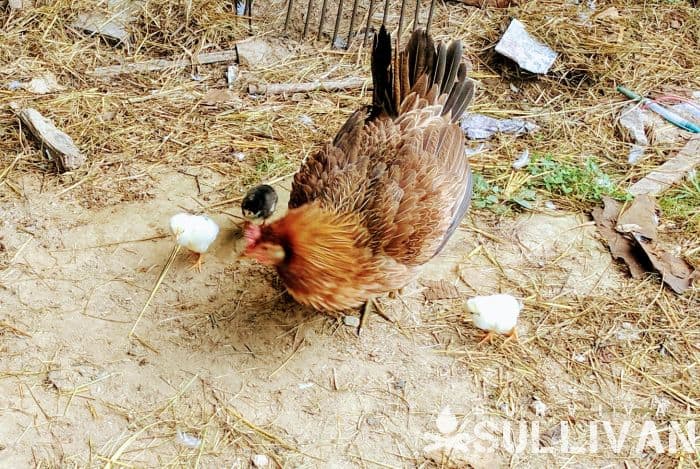
Top 5 Bantam Chicken Breed Egg Layers:
- Easter Egger
- Leghorns
- Brahma
- Sussex
- Plymouth
Space and Portability
You can keep two mature Bantam chickens in the same amount of space required to house on standard size mature chicken. If you want to keep your prepper retreat or survival homestead portable, banty chickens are the way to go.
You can humanely put six mature Bantams in a large metal dog cage to not just transport them but to use as a portable coop during a bugout situation. Such dog crates are sturdy and lightweight, making them an excellent choice of SHTF chicken housing.
Purchasing or building a dog crate style container of this type and simply putting some rubber roofing or similar protective material on the back, top, and exposed size can create a permanent everyday chicken coop that can be picked up and moved on a second’s notice.
Placing multiple crates next to each other will allow you to inexpensively keep a large flock of Bantam chickens in a portable manner. The double door versions of the dog crates would make it simple to place multiple in a line with the doors opened to allow the birds more room to move about.
The doors fold back flat so there would be no dangerous gap in between each cage to allow a predator to get in or a banty to get out. Tying the cages together with some thin wire for added security is a simple way to garner extra peace of mind – and one that can be undone in seconds with a pair of snips.
History of Bantam Chickens
Bantam chickens originated on the coast of Indonesia in the seaport town of Bantan. Sailors that visited the seaport on resupply stops became enamored with the unusual little chickens.
The misspoken and misspelled version of the town’s name when it was translated into English was relayed as Bantam and the new miniature chicken breed soon went global.
Do Bantam Chickens Fly?
They most assuredly do. In fact, the banty breeds we keep are far better flyers than the heritage breed Buckeye chickens I was once so excited about raising.
The miniature chickens do not require a tall roosting area in their coop or run. They love to roost, but do not tend to mind doing so close to the ground.
If frightened or attacked it is not uncommon to see Bantam chickens fly up on the top of their coop or a tree right next to it for safety.
In my experience, banty breeds quickly learn that their keepers are a source of not just food but safety – and will come to their aid if they stay put and out of reach of a threat.
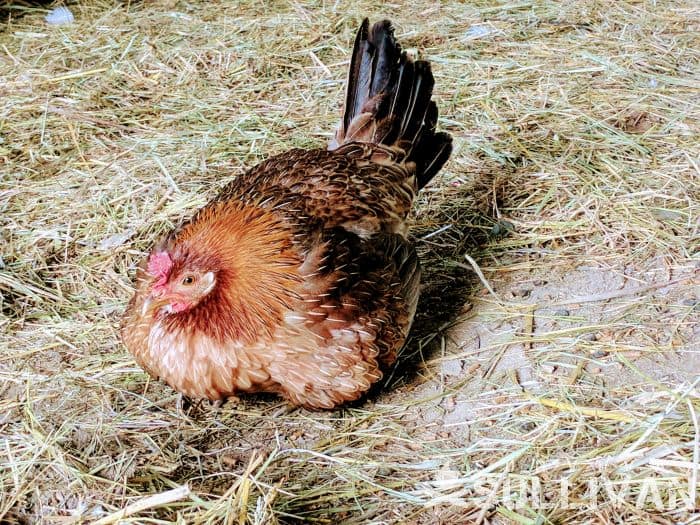
Bantam Chicken Types
There are three different types of recognized Bantam chickens:
- True Bantams – These small chickens do not have a standard size chicken counterpart. They are a naturally occurring breed that was not cross-bred for size by humans. Examples of true Bantams include: Sebright, Rosecomb, and Nankin.
- Developed Bantams – These miniature chickens are the result of unintentional or intentional cross-breeding between a Bantam rooster or hen with a standard size hen or rooster. Popular standard size chicken breeds that are frequently mated with Bantams include: Cochin – Pekin, Japanese, and Belgian. The exact origins of developed Bantam breeds remains largely unknown in many cases because the initial line developed can be hundreds or thousands of years old. Some of the standard size birds that were crossbred are now heritage breeds, endangered, or even extinct.
- Miniaturized Bantams – Poultry birds of this type were all intentionally cross-bred with a standard size chicken by amateur or professional keepers. Common crosses include Cochin – Pekin, Rhode Island Red, and Orpingtons.
True Bantam Breeds
| Breed | Cockerel – Rooster Weight | Pullet – Hen Weight |
|---|---|---|
| Modern Game | 1.3 to 1.4 pounds | 1.1 to 1.3 pounds |
| Sebright | 1.3 to 1.4 pounds | 1.1 to 1.3 pounds |
| Japanese | 1.4 to 1.6 pounds | 1.3 to 1.4 pounds |
| Silkies | 2.0 to 2.3 pounds | 1.8 to 2.0 pounds |
| Rancomb | 1.4 to 1.6 pounds | 1.3 to 1.4 pounds |
| American Game | 1.7 to 1.9 pounds | .1.5 to 1.7 pounds |
| Belgian D’Uccle | 1.4 to 1.5 pounds | 1.1 to 1.3 pounds |
| Old English Game | 1.4 – 1.5 pounds | .1.3 – 1.4 pounds |
| Nankin | 1.4 to 1.5 pounds | 1.3 to 1.4 pounds |
| Dutch | 1.2 to 1.3 pounds | 1.1 to 1.3 pounds |
13 Best Bantam Breeds To Raise
1. Star Spangled Old English Game Hen
Hens weigh roughly 22 ounces and rooster 24 ounces, on average. The eggs produced as small and typically cream in color or tinted in light shades. The best mating ratio is one rooster to nine females. They prefer roosts that are three feet tall, and hail from Europe.
2. B.B. Red Old English Game Hens
These Bantams are one of the most popular because of their overall climate hardiness, alert demeanor when free ranging, and regular egg production.
They produce small white eggs and are successfully kept in both hot and cold climates. Mature hens and roosters typically weigh roughly one and a half pounds.
3. Black Silkie Bantam
These beautiful little poultry birds mature more slowly than some banty breeds. Hens produce small lightly tinted eggs. Black Silkies are not very heat tolerant and do best in moderate to cooler climates.
Mature hens weigh approximately 32 ounces. Mature roosters typically weigh 36 ounces. Both hens and roosters usually have docile and friendly personalities.
4. Rhode Island Red Bantam
The miniature version of Rhode Island Reds also lay brown eggs – just smaller ones. They are superb egg layers and sitters.
These banty chickens are good free rangers, especially cold tolerant, and docile. Mature roosters weigh in around 34 ounces and hens weigh roughly 30 ounces, on average.
5. Barred Cochin Bantams
These birds were introduced in England by soldiers coming back from China during the 1800s. These miniature poultry birds were dubbed “Pekin” Bantams, and are still commonly referred to that way in most of Europe.
Cochin Bantams are feathered down to their toes, making them appear to be a lot bigger than they truly are. Hens of this breed are incredible sitters and attentive momma birds.
They lay small brown eggs and are both cold and heat tolerant. Both hens and roosters are known to be calm and docile with both the rest of their flock and their keepers.
6. Mottled Cochin Bantams
These Bantams are incredibly colorful poultry birds. Their feathered feet can become a problem when exposed to excessive snow and ice but are otherwise cold weather hardy.. Hens lay small to medium light brown and tinted eggs.
Mottled Cochin Bantams are known to be very docile, even the roosters. Hens typically weigh about 28 ounces and roosters weigh around 32 ounces, on average.
7. Black Tall Buff Japanese Bantam
This banty breed is at least three centuries old. They are an especially quiet and docile Bantam chicken breed. Hens weigh about 28 ounces with roosters weighing in around 32 ounces. Hens of this Bantam breed lay small white eggs and are both diligent mothers and good sitters.
8. Welsummer Bantams
This is sometimes one of the hardest to find of all banty breeds. Lucky for me an Amish neighbor used to raise them and I developed a hardy and stable banty flock from the eggs she gave me to hatch. Welsummer Bantams were developed in Holland during the early years of the 20th century.
They are hands down the best free ranging chicken breed I have ever kept. This miniature chicken breed is a cross between Barnevelders and several other breeds from the same region.
These banty hens lay small yet highly beautiful mahogany eggs. Roosters weigh about 34 ounces on average. Banty hens from this breed typically weigh about 32 ounces.
9. Mille Fleur d’Uccles Bantam
Bantam chickens of this type are docile and avid free rangers. Hens lay cream or tinted small eggs frequently.
They prefer to roost just two to perhaps four feet off the ground. The best breeding ratio for Mille Fleur d’Uccles Bantam chickens is one rooster to six hens.
10. Buff Brahma Bantams
Brahma chickens are confidant and hardy birds, as are their miniature counterparts. Hens of this breed lay small and creamy delicious brown eggs. Roosters weigh in around 38 ounce and hens typically weigh about 34 ounces.
Surprisingly Buff Brahma Bantams chickens do not tend to mature as quickly as some breeds. But these poultry birds are excellent foragers and have ample barnyard smarts when free ranging.
11. Golden Sebright Bantams
This Bantam breed traces its heritage back to 1800s era Europe. Hens commonly weigh around 20 ounces once mature. Golden Sebright Bantams weigh approximately 22 ounces, on average. These docile yet sometimes flighty hens lay lightly tinted to cream small eggs.
The best breeding ratio for this banty breed is one rooster to eight females. They prefer a roost positioned just two feet off the ground but will fly up to four feet high if a sturdy spot suits them.
Golden Sebright Bantams are also great sitters, lay eggs steadily late into the year, and regularly produce diligent momma birds. I have never had to incubate an egg from a hen of this type no matter how much snow is on the ground.
12. Sage Gem Bantam
These Bantam hens are the best egg producers of miniature breeds that I have yet come across. Like the equally hardy Easter Egger breed, Sage Gem hens lay olive, brown, sage green, and earth-toned colored eggs. Hens weigh in at 30 ounces and roosters at 32 ounces, on average.
Sage Gem Bantam chickens are voracious free-ranging poultry birds. They regularly take care of pests in and around our growing plots, which is why I own them:
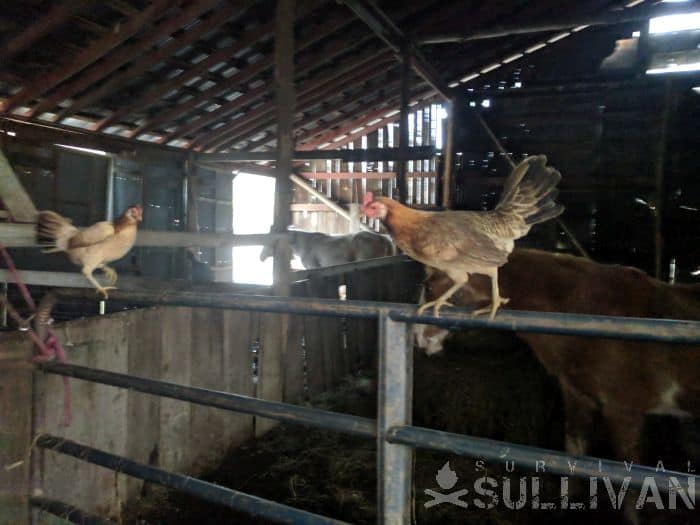
These banty chickens seem to remain keenly aware of potential predator threats when free-ranging and take to the trees quickly to escape danger.
13. White Crested Black Polish Bantam
The hens from this breed lay small white eggs – and a lot of them. The White Crested Black Polish Bantam hen is also an exceptionally quiet poultry bird breed. Roosters typically weigh about 30 ounces and mature hens weigh in around 26 ounces.
All of the crested feathers on their heads could be why members of this quality survival chicken breed are less adept at recognizing danger quickly. Keeping a flock of guineas around is a great idea from both a chicken flock protection and an OPSEC viewpoint.
Guineas that live with and roam with not just the White Crested Black Polish chickens but the entire flock, will rapidly sound the alarm bell when a threat is looming and fight predators even far larger than themselves to protect the flock.
Within many of these Bantam chicken breeds there are multiple and equally worthwhile variations of the birds, especially the Old English breed.
Can You Keep Bantams With Standard-Sized Chickens?
In my experience, yes. I have kept both standard and miniature chickens, along with ducks and guineas in the same coop and run. If you have a particular rowdy rooster or territorial hen, problems could result – just as they would with any new addition to the flock.
Due to their smaller size, keeping banty chicks in the brooder longer until they are large enough to fend for themselves and not get trampled in the coop and run can be entirely necessary.
I always place not only Bantam chicks but any new arrival to the flock in the outdoor brooder attached to the coop run for days to even a few weeks, before turning all of the birds out together.
A pre-release plan like this allows all of the flock members to get to know each other quite well but in an entirely safe manner.
By the time I release the banty chicks into the coop and run everyone is well acquainted and the newbies are not looked upon as invaders.
Bantam Chicken Care
There is no special care needed for keeping Bantam chickens. These poultry birds take up less space and eat less food than standard chicken breeds, but those are the only real differences in husbandry habits.
Sexing a Bantam chick often takes longer than sexing a standard breed chicken based upon comb and wattle size or other common physical attributes because they often mature more slowly.
Final Thoughts
Banty chickens are often dubbed the “flower garden” or the poultry bird universe. These beautiful little birds are not only excellent foragers but are prone to highly adept barnyard smarts.
Being a smaller bird Bantam chickens may seem more susceptible to predator attack, especially from hawks. But, in my years of keeping both standard and banty chicken breeds, I lose the miniature birds to both disease and predators far less often than their larger peers.
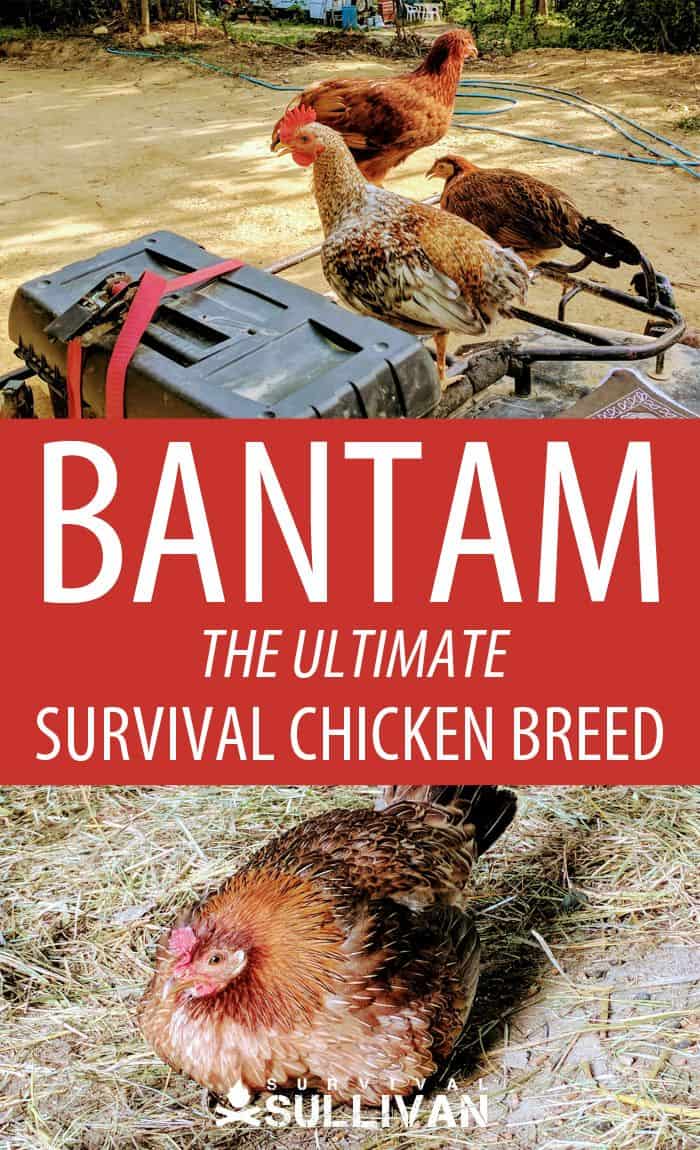

Tara Dodrill is a homesteading and survival journalist and author. She lives on a small ranch with her family in Appalachia. She has been both a host and frequent guest on preparedness radio shows. In addition to the publication of her first book, ‘Power Grid Down: How to Prepare, Survive, and Thrive after the Lights go Out’, Dodrill also travels to offer prepping tips and hands-on training and survival camps and expos.

Beautiful little birds..thank you so much for this valued information…
Nice write-up. I have raised a mixed flock for several years. I’d highly recommend Wyandottes for excellent cold and heat hardiness and decent brown eggs. California Whites are also cold hardy excellent for egg production (a Leghorn cross).
One correction… Modern Games are not a true bantam. Breeders are pretty rare, but standard size Modern Games do exist. I have raised Silver Sebrights (which I find much prettier than Gold Sebrights)…they are difficult to breed due to low fertility in the roosters and lower egg production in the hens. I’ve also raised Modern Game bantams and they may be my favorite breed…the roosters are pretty docile, and both sexes are generally very friendly and curious, but they require a winter heat supplement in cold climates.